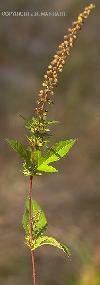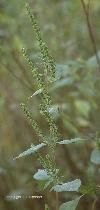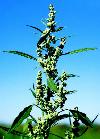| Plant Photo |
Scientific Name |
Common Name and Description |
Seed Photo |
 |
Amaranthus spinosus |
Common Name: Spiny Amaranth or Pigweed
Leaves: Alternate, ovate-lanceolate to ovate, glabrous to sparingly pubescent (covered with short hairs - downy), 3-10 cm long
Flowers: Male and female flowers, occasional flowers perfect, spikes numerous, 5-15 cm long
Fruit: Black, nearly round, 0.7-1 mm in diameter
Habitat: In waste ground, sandy loamy soil
Range: East third of Texas, west to Dallas, Travis and Cameron counties
Group: Dicot
Family: Amaranthaceae
Growth Habit: Forb/Herb - weedy, long (to 4 dm taproot), stems stout and succulent, erect, branched, 3-12 dm tall
Duration: Annual
U.S. Nativity: Probably tropical in origin (Correll and Johnston); Native (USDA) |
 |
 |
Ambrosia trifida |
Common Name: Giant Ragweed
Leaves: Alternate or opposite at the lower nodes, in some species opposite nearly throughout, entire or palmately lobed or (usually) pinnately lobed or dissected
Flowers: Ray flowers absent, lacking pappus and corolla, phyllaries fused about flowers to form a hard indehiscent nutlike receptacle
Fruit: Brown achene ~4 mm
Habitat: Abundant in seasonally moist stream bottoms and overflow areas
Range: Throughout the eastern and northern halves of Texas; the midwest, and the central United States to the Rocky Mountains and from southern Canada to northern Mexico
Group: Dicot
Family: Asteraceae
Growth Habit: Subshrub/Forb/Herb - tall erect annual taprooted herb 1-3 meters tall, stem angled, striate and scabrous
Duration: Annual
U.S. Nativity: Native |
 |
 |
Helianthus annuus |
Common Name: Sunflower
Leaves: Leaves always opposite at least at the base of the stems and usually alternate above, ovate, obtuse or less commonly acute and coarse-textured
Flowers: Disc 3-5 cm across, rays 21-35 are 3-5 cm long and 10-15 mm broad
Fruit: A dark achene with white stripes 4-7 mm
Habitat: Fields, borders, waste places and gardens
Range: Rare in northeast Texas; found in the east and central United States and south Canada
Group: Dicot
Family: Asteraceae
Growth Habit: Forb/Herb - taprooted annual, stems 5-25 dm tall
Duration: Annual
U.S. Nativity: Native |
 |
 |
Iva annua |
Common Name: Annual Marshelder or Sumpweed
Leaves: Alternate or opposite 3-12 cm long, ovate or becoming lanceolate upward
Flowers: Staminate flowers 9-17, corolla about 2.5 mm long, pistillate flowers 3-5, corollas about 1.5 mm long
Fruit: Achenes 2-4.5 mm long, brown, broadly ovate, lenticular
Habitat: Fields, borders, waste places and gardens
Range: East half of Texas, west to Wheeler, Taylor, Travis, DeWitt and Hidalgo counties; most of the eastern United States, west to Nebraska, Kansas, Oklahoma and Texas
Group: Dicot
Family: Asteraceae
Growth Habit: Forb/Herb - taprooted 4-20 dm tall
Duration: Annual
U.S. Nativity: Native |
 |
 |
Chenopodium album |
Common Name: Pigweed, Goosefoot, Lamb's-Quarters, or Wild Spinach
Leaves: Oval-rhombic, rarely ovate or lanceolate, 2.5-8 cm long, usually conspicuously longer than broad, obtuse or rounded and apiculate at the apex, often shallowly 3-lobed, pale-green and glabrate above, densely farinose beneath
Flowers: Flowers in large glomerules, terminal stout erect or ascending paniculate spikes to 3 dm long, grayish-green
Fruit: Black, 1.1-1.5 mm broad, nearly smooth to minutely pitted
Habitat: Fields, fencerows and waste places.
Range: Newfoundland to Florida, west to Yukon and British Columbia, south to Mexico and South America, also in North Africa
Group: Dicot
Family: Chenopodiaceae
Growth Habit: Forb/Herb - pale-green, sometimes turning reddish, 6-30 dm tall
Duration: Annual
U.S. Nativity: Eurasian (Correll and Johnston); Native and Introduced (USDA) |
 |

